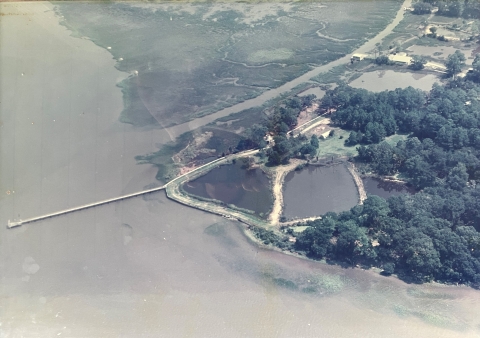About Us
Bears Bluff National Fish Hatchery (NFH) is a part of the Warmwater Fisheries and Aquatic Conservation Program in the South Atlantic-Gulf Region of the U.S. Fish and Wildlife Service (USFWS). Situated in coastal South Carolina, the facility sits on the banks of the Wadmalaw Sound and is nestled among salt marsh salt marsh
Salt marshes are found in tidal areas near the coast, where freshwater mixes with saltwater.
Learn more about salt marsh and lowland forest. The site provides ideal opportunities for researching and improving upon culture and propagation techniques for freshwater, saltwater and anadromous aquatic species.
Our Mission
Since 1871, National Fish Hatcheries have been applying science-based approaches to conservation challenges. We work with our partners and engage the public to conserve, restore, and enhance fish and other aquatic resources for the continuing benefit of the American people. Conservation is at the heart of what we do, and we recognize that we do this work for the American people–both the present generation who benefit today and future generations who will inherit our legacy of conserving America’s aquatic resources.
As part of the Fish and Aquatic Conservation program, our work focuses on geographic areas and species with the greatest needs. Through biological inventories, assessments, modeling, and conservation strategies we work with partners to better understand and alleviate threats to aquatic resources by propagating fish and other aquatic species to enhance wild populations, strategically improving habitat, restoring the connectivity of the nation’s waterways, and preventing new infestations of aquatic invasive species invasive species
An invasive species is any plant or animal that has spread or been introduced into a new area where they are, or could, cause harm to the environment, economy, or human, animal, or plant health. Their unwelcome presence can destroy ecosystems and cost millions of dollars.
Learn more about invasive species .
Our History
In 1946, a generous donation of land and funds by H. Jermain Slocum resulted in the establishment of Bears Bluff Laboratories. Directed by Robert Lunz and funded by the Slocum and Lunz Foundation, the non-profit marine research station focused on marine ecology and monitored the status of the commercial fisheries in South Carolina. Between 1946 and 1952, the Laboratory built-up the property to include laboratories, a dormitory, work shops, salt water and fresh water ponds, and a dock that supported a 40 foot research vessel. Partnering with College of Charleston and the Medical University of South Carolina in 1954, the marine research station expanded and eventually lead to the establishment of the Department of Natural Resources - South Carolina Marine Division. With the establishment of the Marine Division in 1970, research at Bears Bluff Laboratories was moved to the Fort Johnson Laboratory.
During the 1970s, the Environmental Protection Agency took over the property and continued to focus on marine ecology research. Much of their work revolved around toxicology and evaluating the effects various chemicals had on marine organisms.
Then, in 1981 the Fish and Wildlife Service took over the property and established the 35-acre Bears Bluff National Fish Hatchery as a unit of Orangeburg National Fish Hatchery. The hatchery's primary mission at the time was to establish and provide assistance to federal and state partners with the restoration and mitigation of declining fish populations such as striped bass, Atlantic sturgoen, shortnose sturgeon, and red drum.


